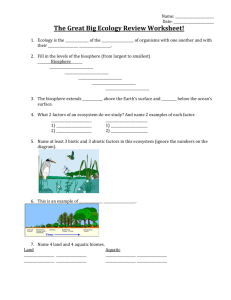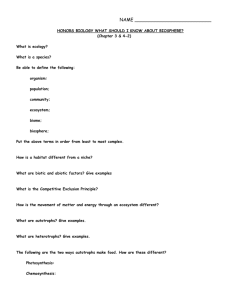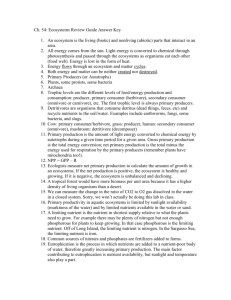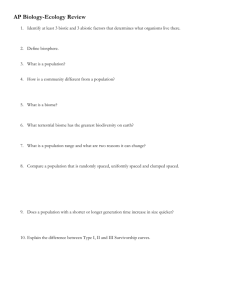Chapter 3: The Biosphere
advertisement
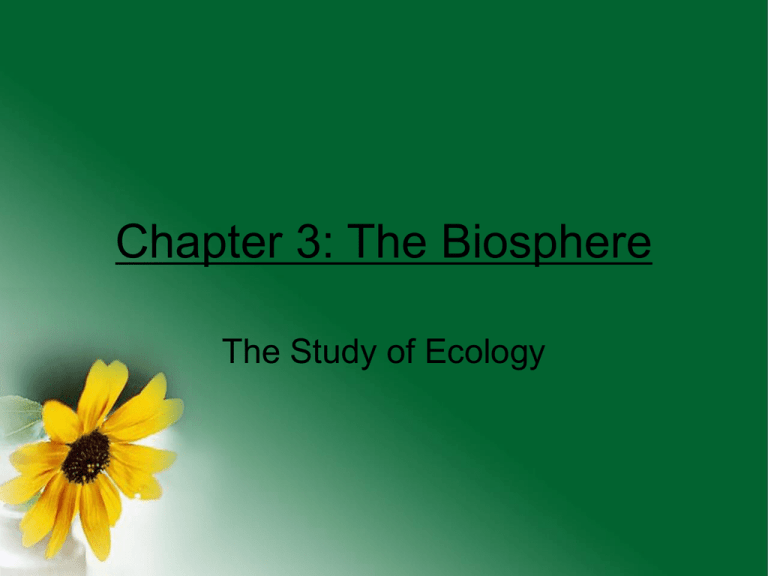
Chapter 3: The Biosphere The Study of Ecology What is Ecology? • Ecology is the scientific study of interactions among organisms and between organisms and their environment Why do we study ecology? • We live in the natural world and use its resources (water, space,food, etc) • The natural world effects our lives (weather, fire, economy) • To protect biodiversity Levels of Organization • Ecologists recognize there is a hierarchy of organization in the environment: biosphere, biome ecosystem, community, population, and organisms Levels of Organization What is a Biosphere? • Part of Earth in which life exists including land, water, and air or atmosphere What is a Biome? Temperate Forest Tundra • A group of ecosystems that have the same climate and similar dominant communities What is an Ecosystem? • A collection of all organisms that live in a particular place, which includes the nonliving, or physical, environment What is a Community and a Population? • A community is assemblage of different populations that live together in a defined area • A population is a group individuals that belong to the same species and live in the same area How Do We Study Ecology? • Observing • Experimenting • Modeling (Ecological phenomena that occur over long periods of time) How Do Organisms Obtain Energy in an Ecosystem? • Sunlight is the main energy source for life on Earth • Autotrophs will then use the energy from the sun (or chemicals) to make their own food • Autotrophs are also known as producers • Examples of autotrophs: plants, algae, cyanobacteria How Do Organisms Obtain Energy in an Ecosystem? • Autotrophs use photosynthesis to convert sunlight, carbon dioxide, and water into oxygen and carbohydrates How Do Organisms Obtain Energy in an Ecosystem? • What if there is no light in the ecosystem? • The autotrophs will use chemosynthesis, which is a process that uses chemical energy to produce carbohydrates (ex: bacteria living in volcanic vents) How Do Organisms Obtain Energy in an Ecosystem? • Organisms that rely on other organisms for energy are known as consumers or heterotrophs Types of Heterotrophs • Herbivores- consume only plants • Carnivores- consume only meat • Omnivores- consume both plants and animals • Detritivores- consume plant and animal remains (earthworms, mites, crabs) • Decomposer= breaks down organic matter to obtain energy (bacteria & fungi) Feeding Relationships • Energy in an ecosystem flows in one direction (from sun to the heterotrophs) • Food chain- a series of steps in which organisms transfer energy by eating and being eaten Food Chain Food Web Transfer of Energy • Each step in a food chain or food web is called a trophic level • Autotrophs make up the first trophic level, consumers make up 2nd, 3rd, 4th or higher levels • Only about 10% of energy is transferred to organisms at the next trophic level Transfer of Energy • If 10% of solar energy is captured by plants then animals who eat the grass gain only 10% of that energy (1%), animals who those animals gain 10% from that (.1%) • 10% --> 1% --> .1% What is Biomass? • Biomass is the total amount of living tissue within a given trophic level • A biomass pyramid can show you much food is available to each trophic level Recycling Matter in the Biosphere • Elements, chemical compounds, and other forms of matter are passed from one organism and from one part of the biosphere to another in biogeochemical cycles Important Biogeochemical Cycles • • • • Water cycle Carbon Cycle Nitrogen Cycle Phosphorus Cycle The Water Cycle The Water Cycle • Water moves between the ocean, atmosphere, and land • Water evaporates from bodies of water into the atmosphere • Water can also enter the atmosphere through transpiration (process by which water is lost through the leaves of plants) Nutrient Cycles • A nutrient is a chemical substance that an organism needs to sustain life • Important nutrient cycles – Carbon Cycle – Nitrogen Cycle – Phosphorus Cycle The Carbon Cycle • Carbon’s Roles – Ingredient in living tissue – Important component of animal skeletons (CaCO3) – Important component of the atmosphere (CO2) The Carbon Cycle • Carbon enters the atmosphere by: – Respiration – Geochemical processes – Human activities • Carbon is taken up by: – Photosynthesis – Burial and decomposition of dead organisms (formation of fossil fuels) The Carbon Cycle CO2 in Atmosphere CO2 in Ocean The Nitrogen Cycle • The roles of nitrogen: – Important component of amino acids – Major component of fertilizer (NO3-) – Major component of atmosphere (N2) The Nitrogen Cycle • Nitrogen gas (N2) cannot be used by plants so it must be converted into a usable form • Soil bacteria convert nitrogen gas into ammonia (NH3) in the process of nitrogen fixation • More soil bacteria convert ammonia into nitrates (NO3-) and nitrites (NO2-) a usable form • Other soil bacteria then convert nitrates and nitrites back into nitrogen gas, which is known as denitrification The Nitrogen Cycle The Phosphorus Cycle • Roles of Phosphorus – Important component of DNA and RNA • Does not enter atmosphere (gas) • Steps – Phosphorus is found in rocks and sediment which gets moved by water – Plants absorb phosphorus in the form of phosphate from soil and water – Heterotrophs consume plants What is a Limiting Nutrient? • A nutrient that is scarce of cycles very slowly • When an aquatic ecosystem receives a large amount of a limiting nutrient it immediately increases the amount of algae, which is known as algal bloom Algal Bloom • What is the result of algal bloom?

